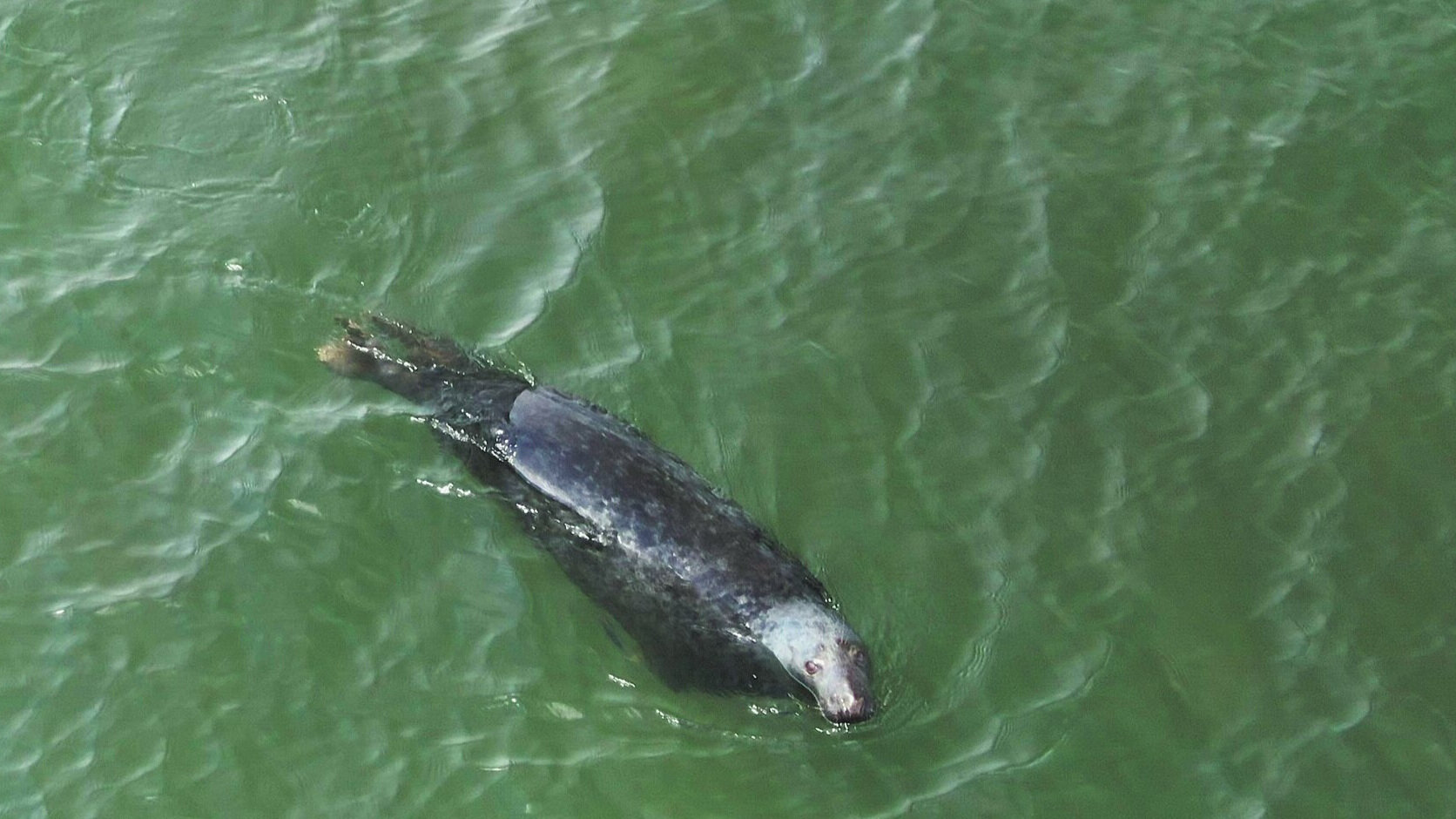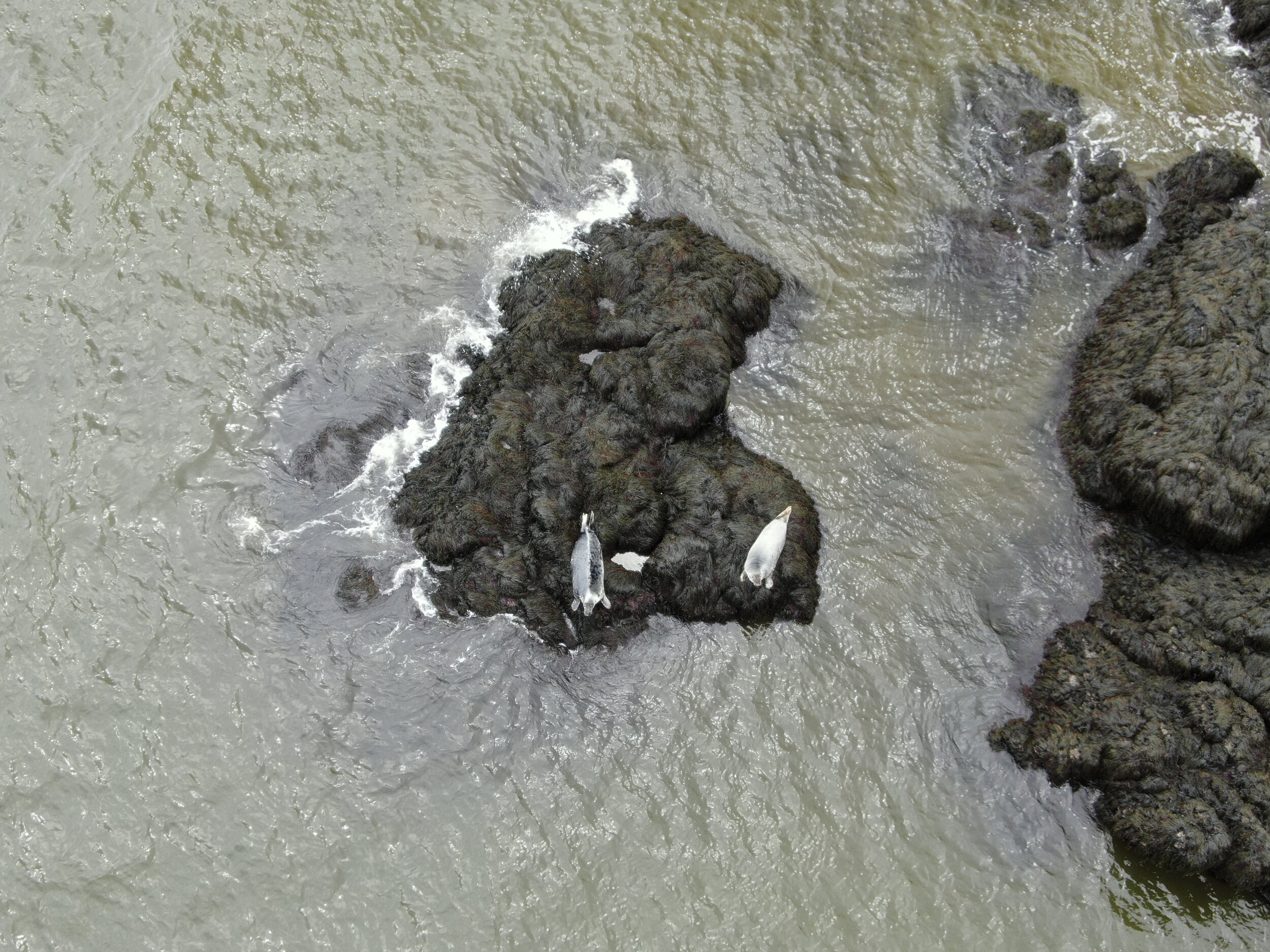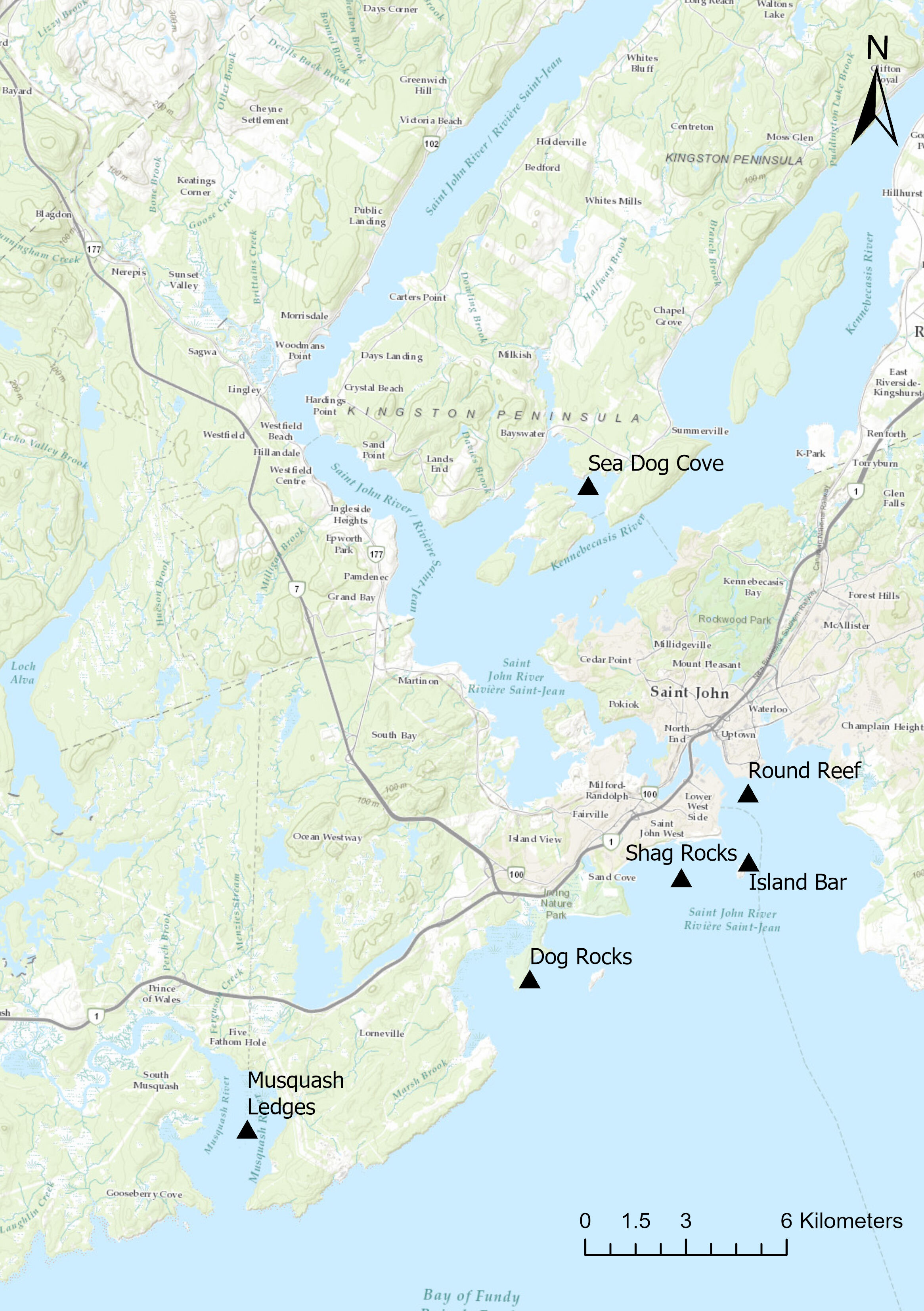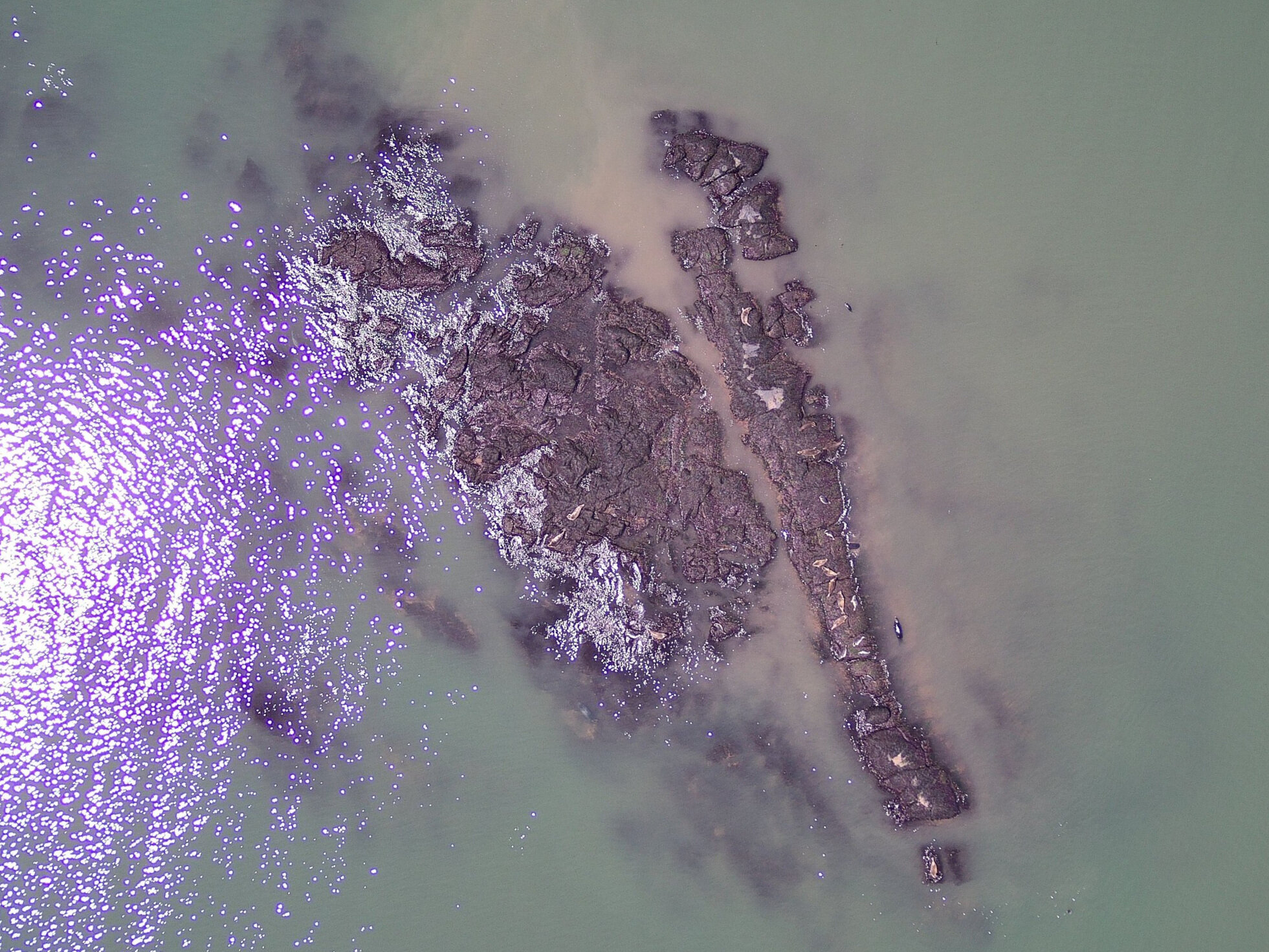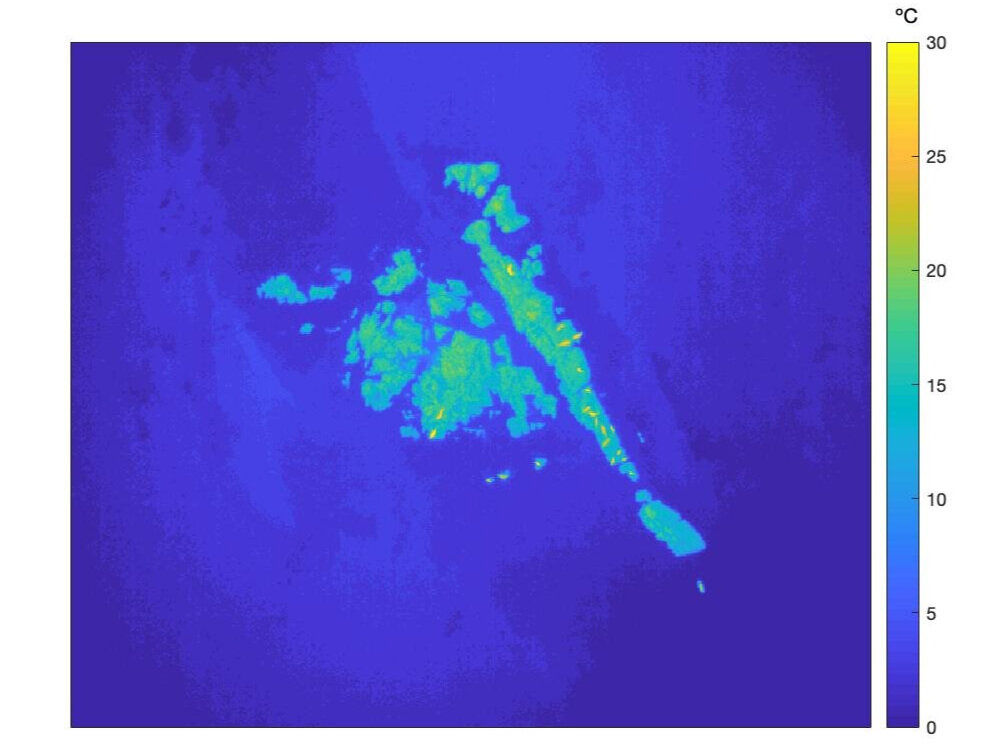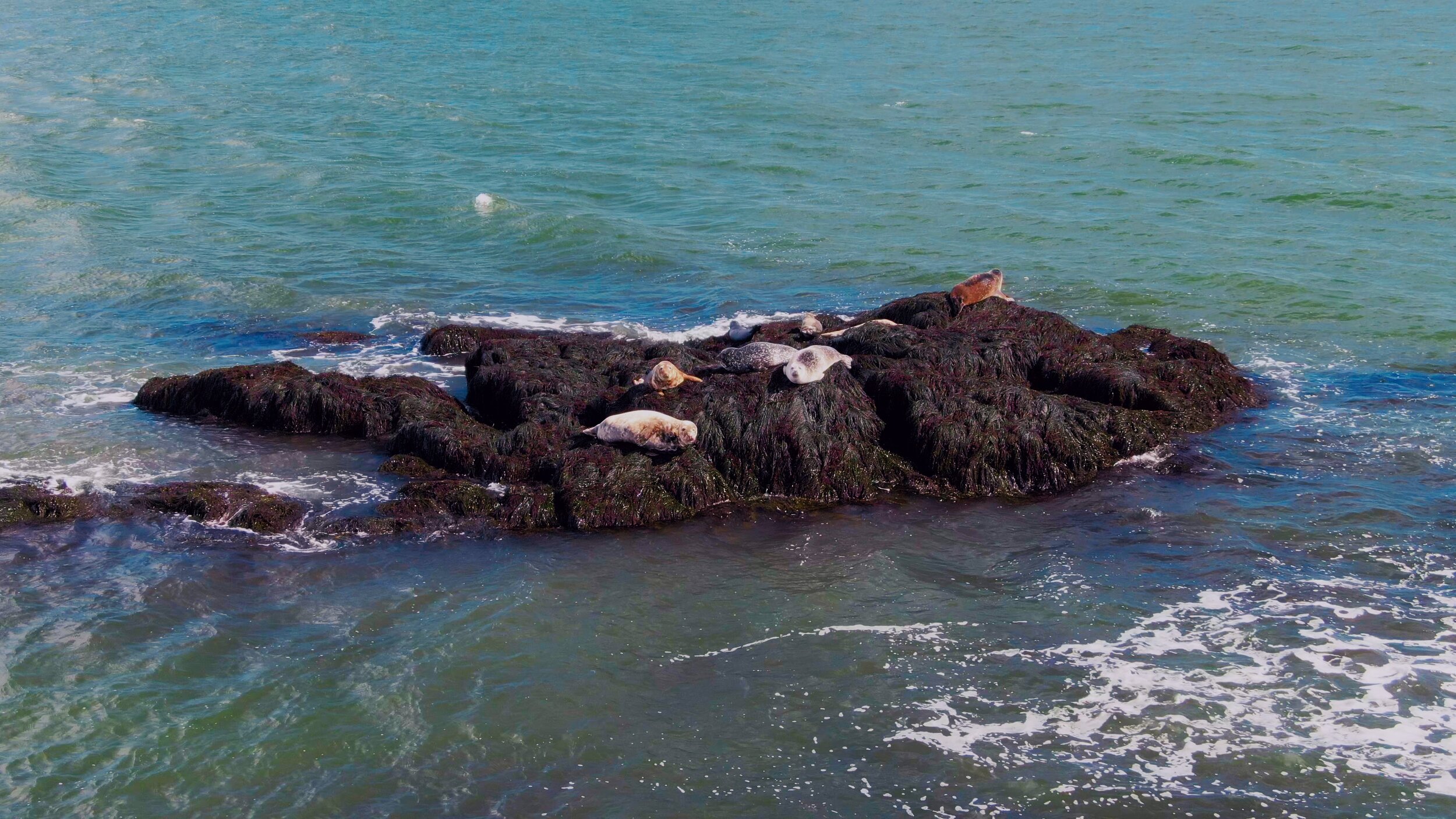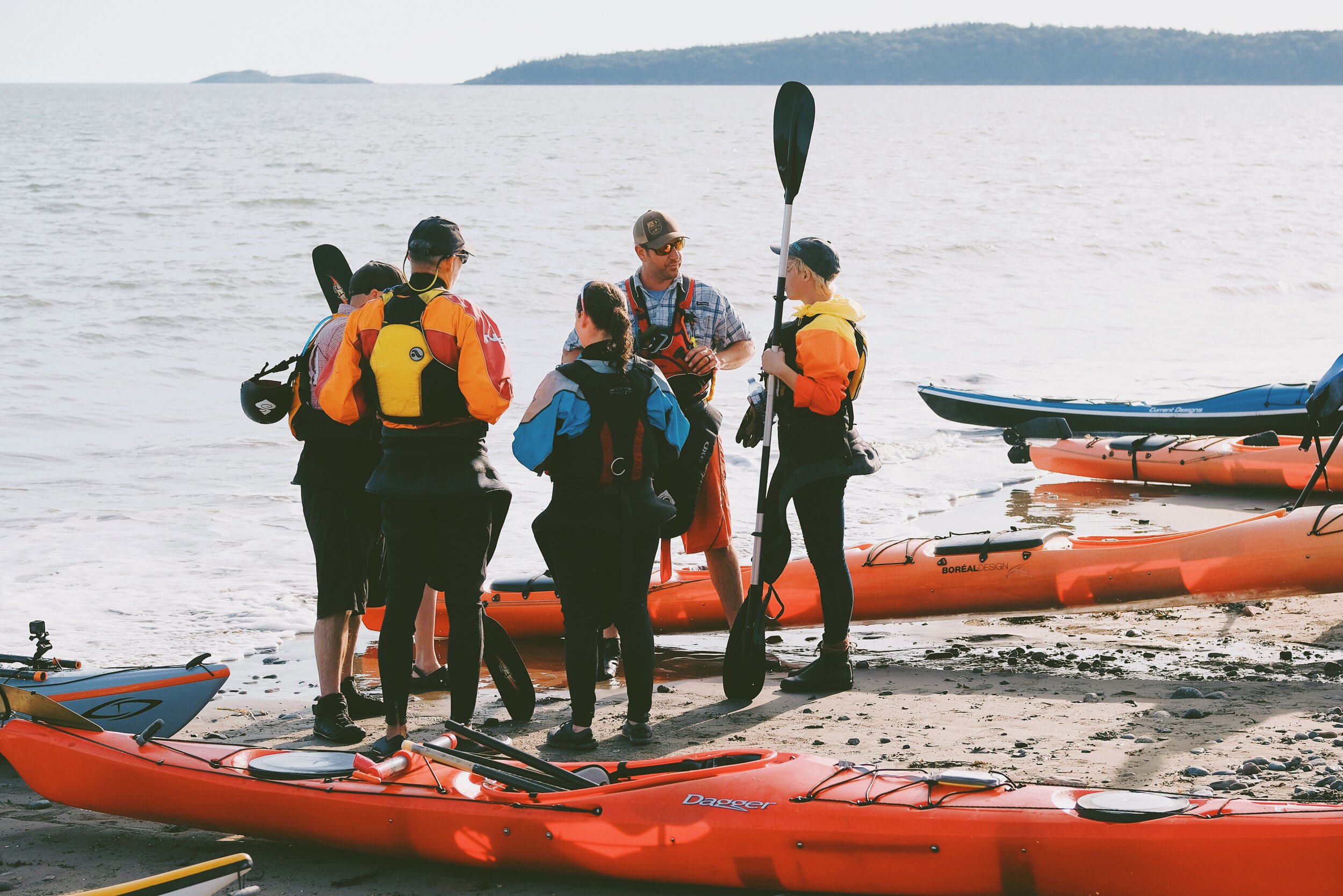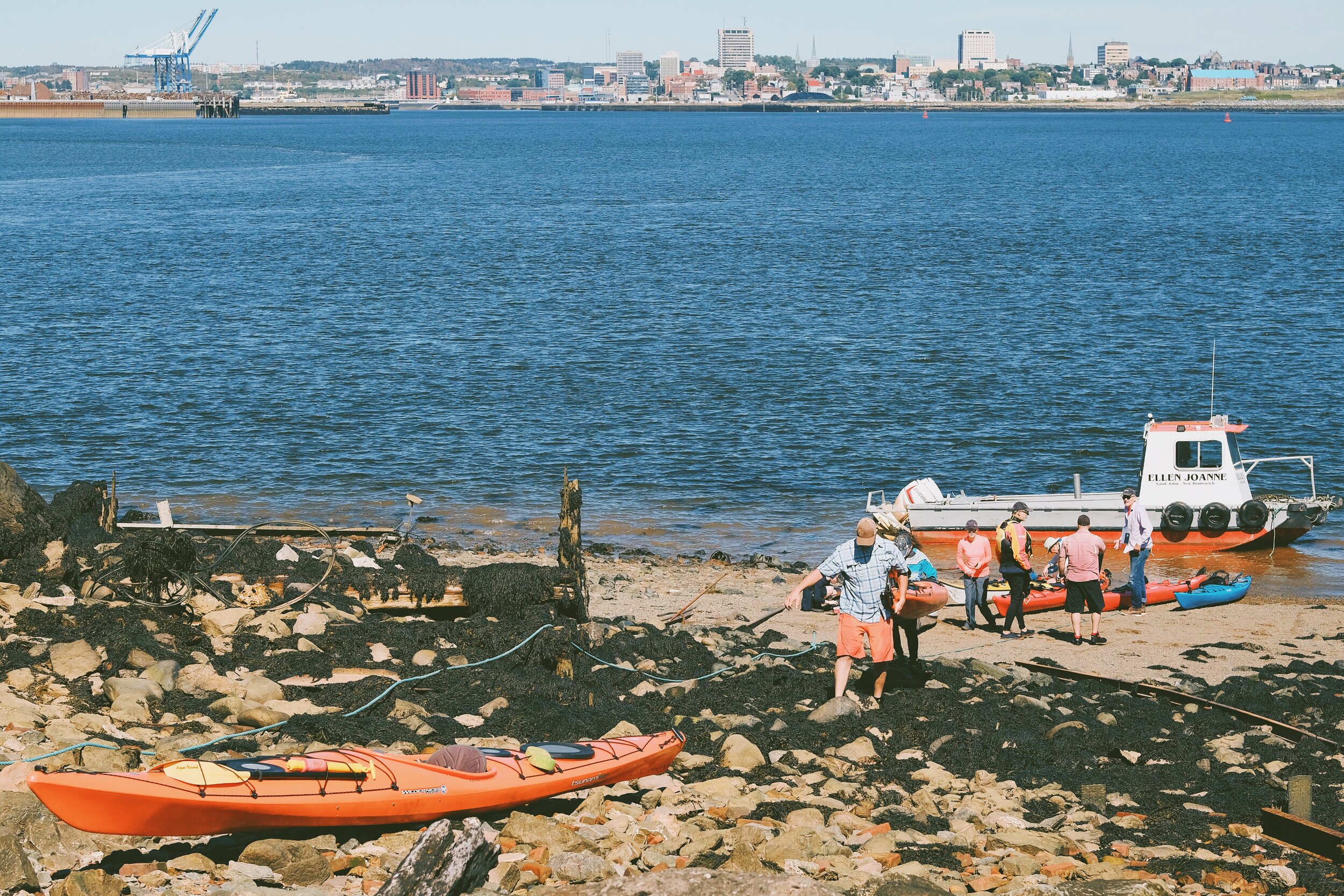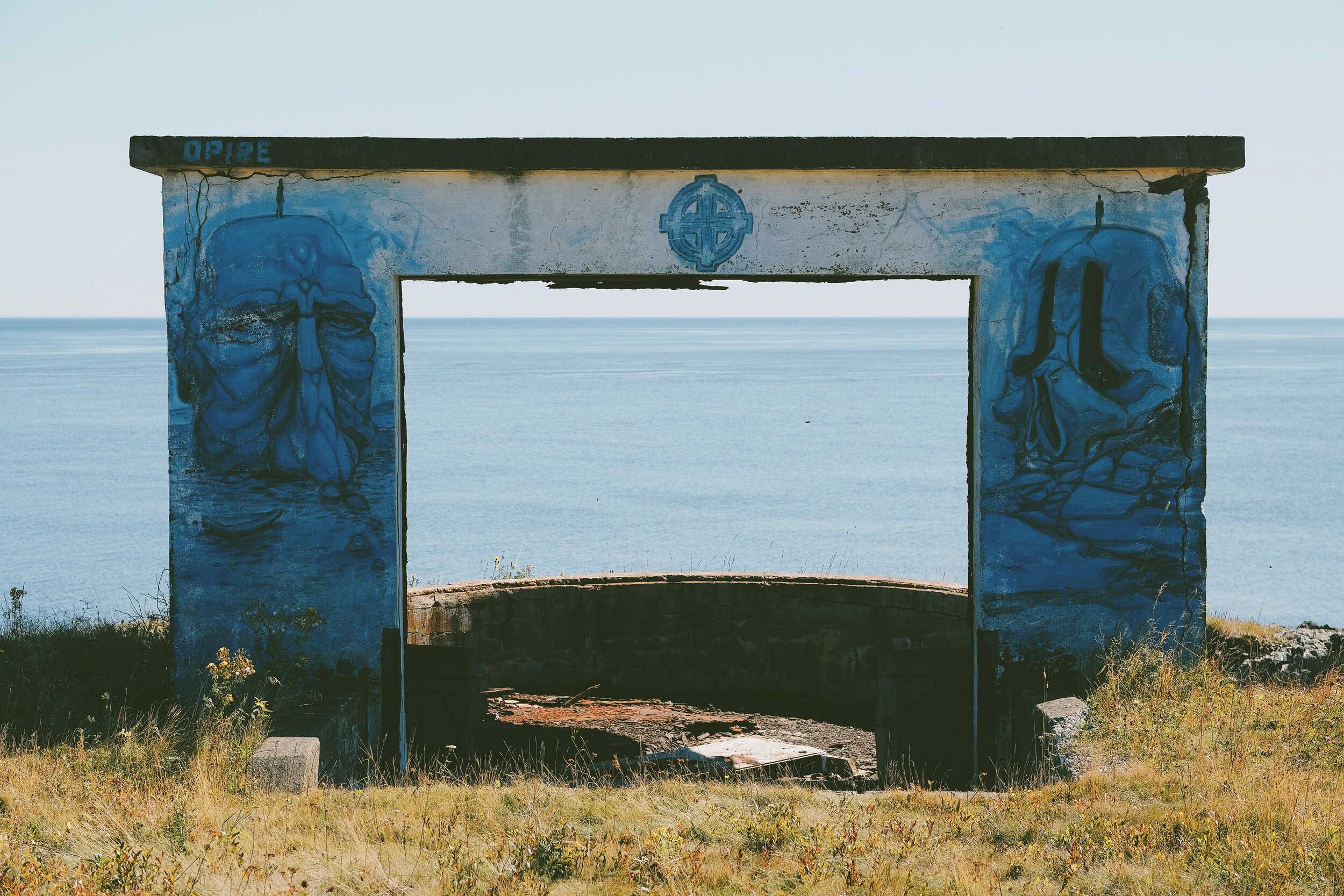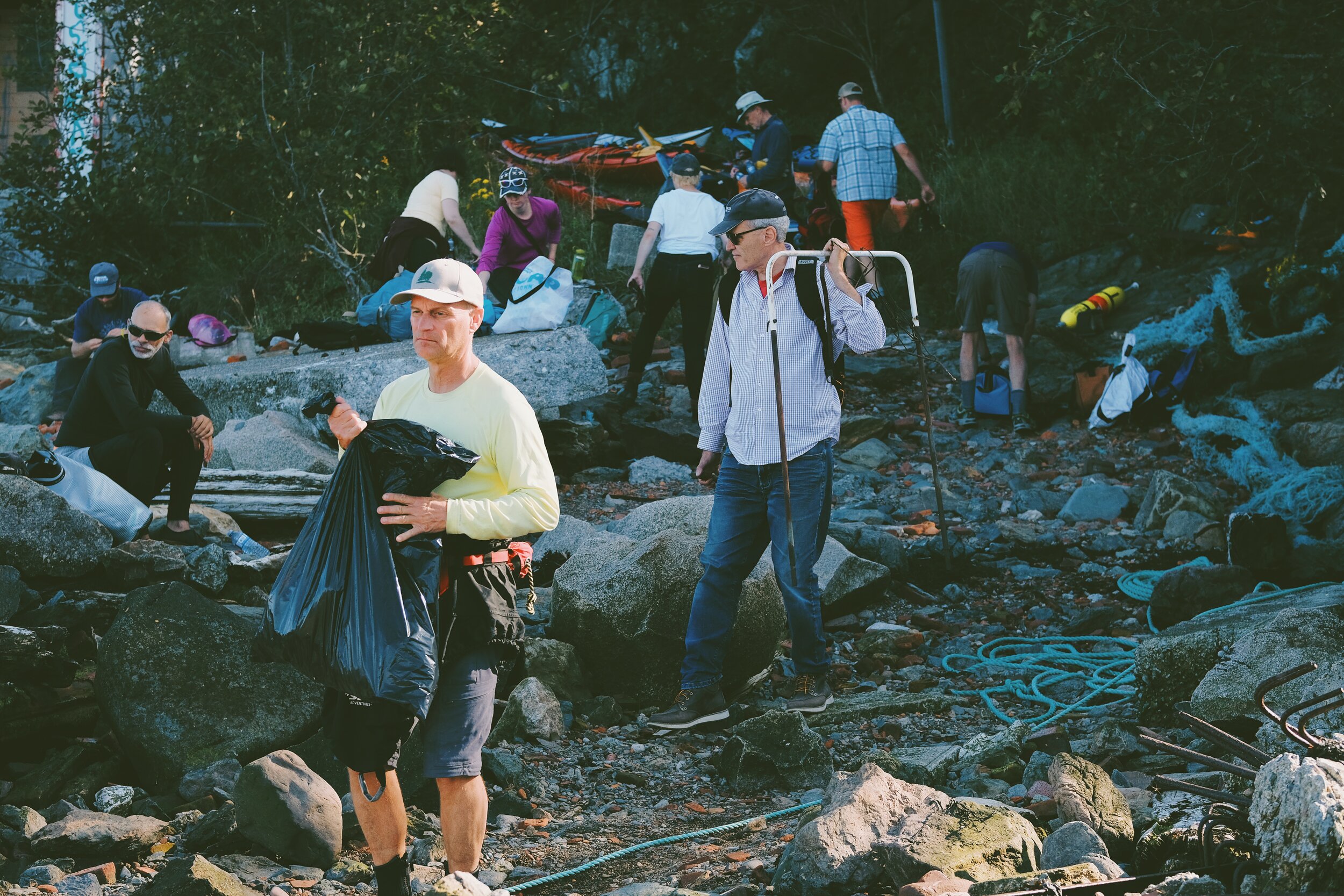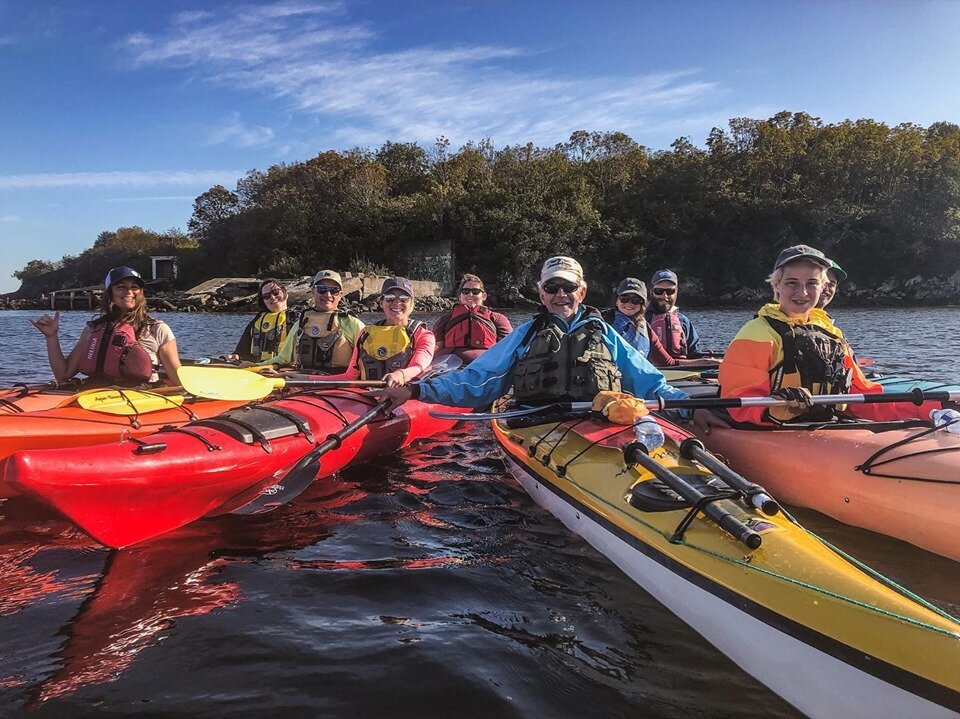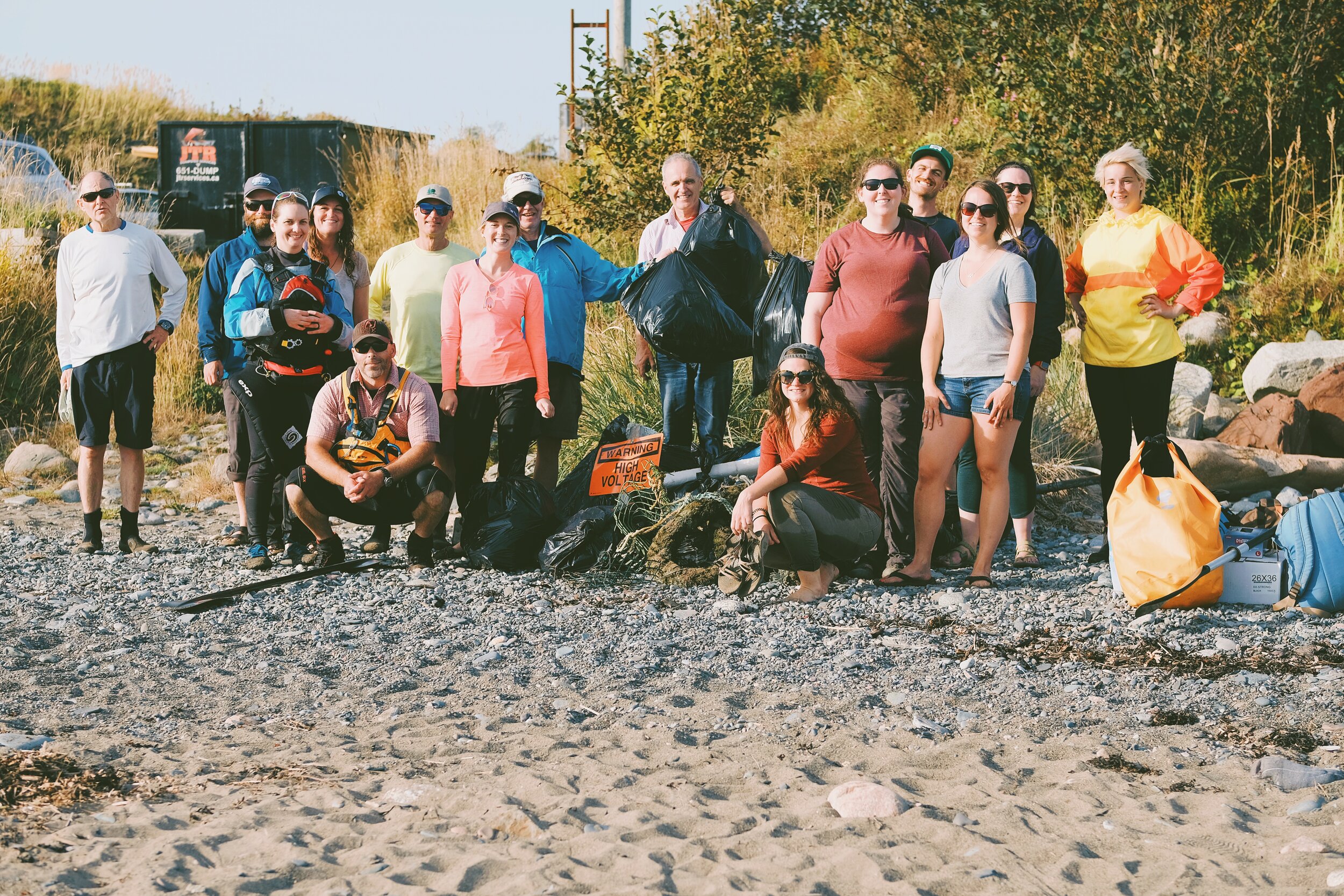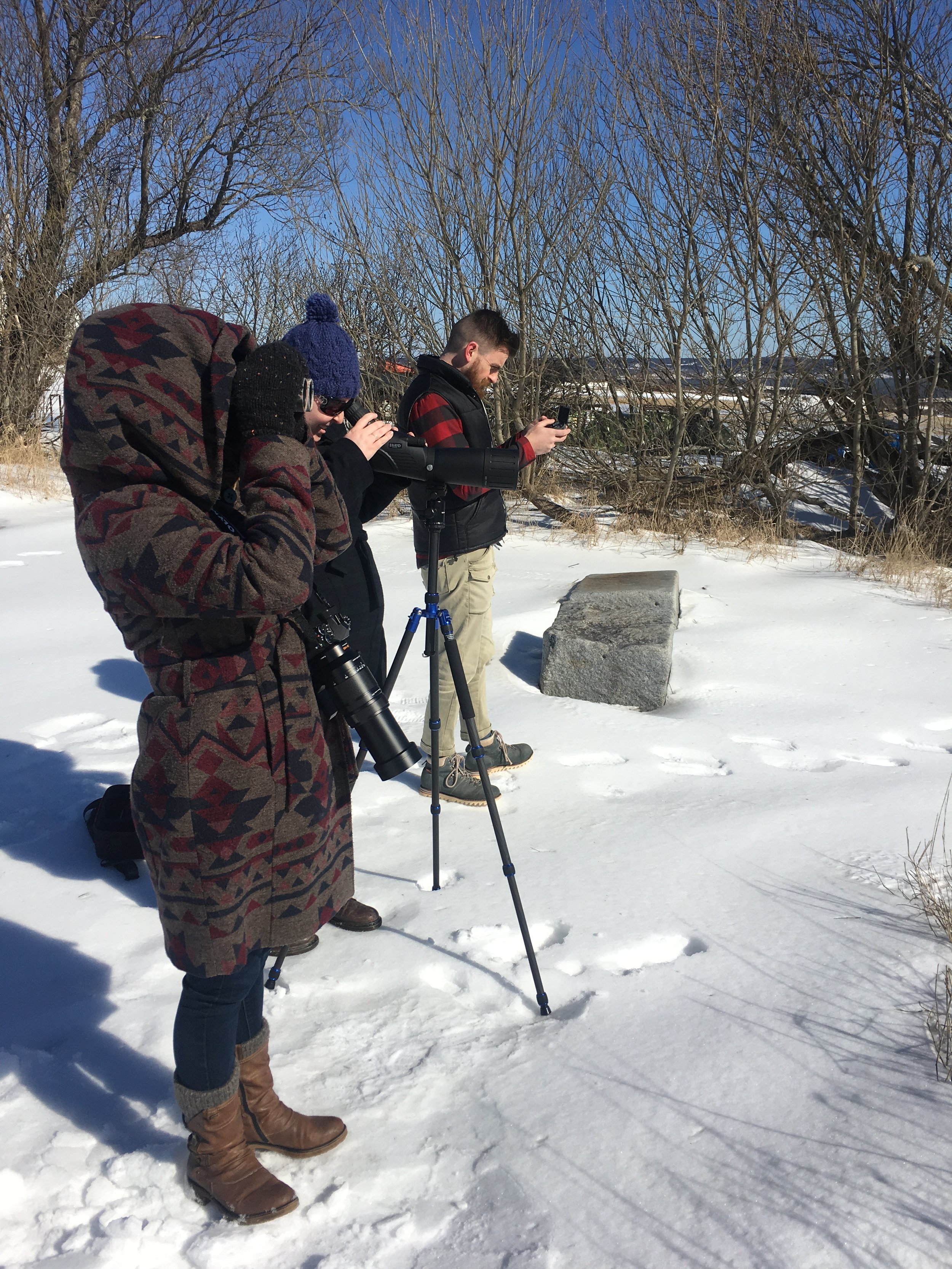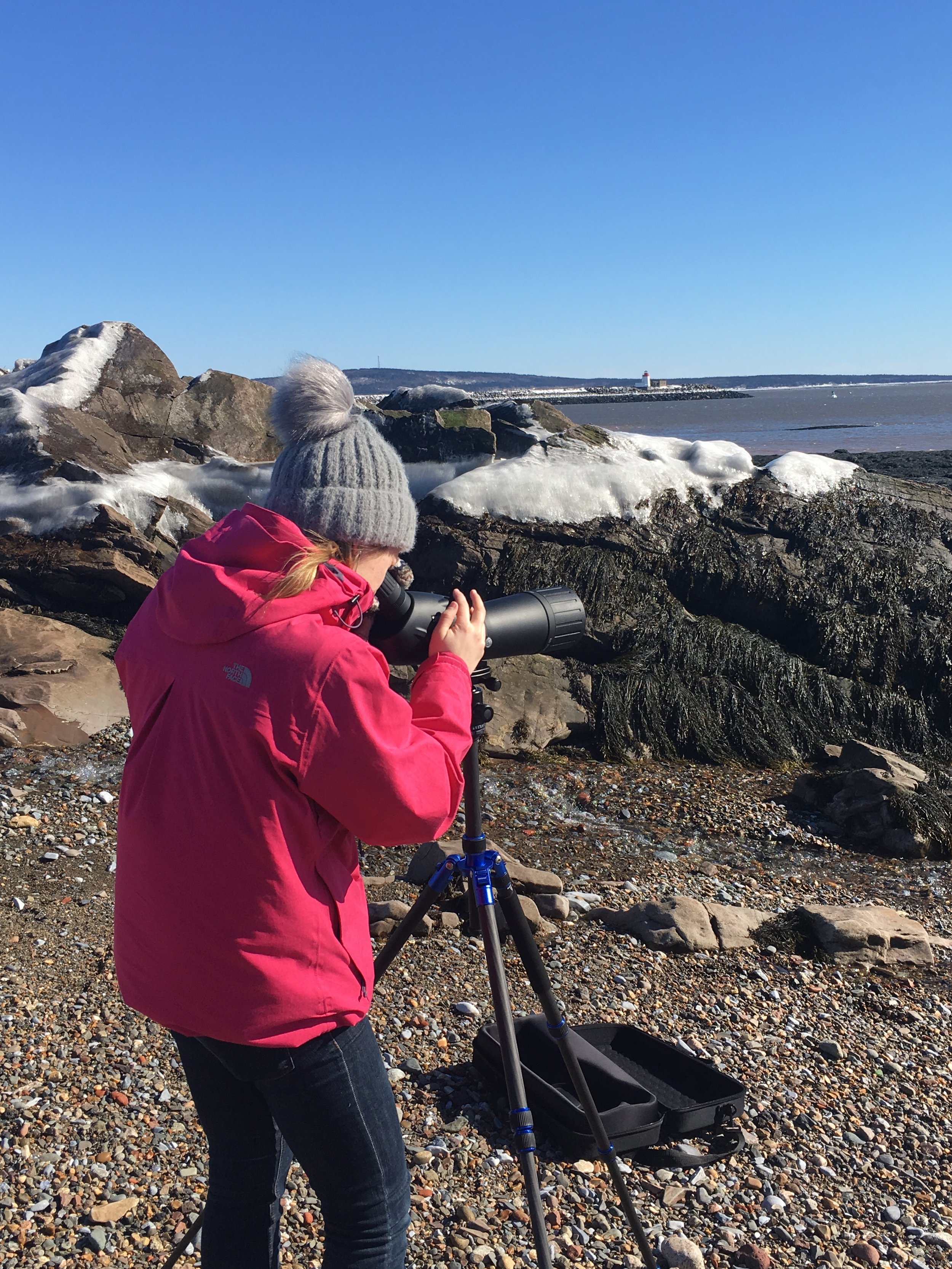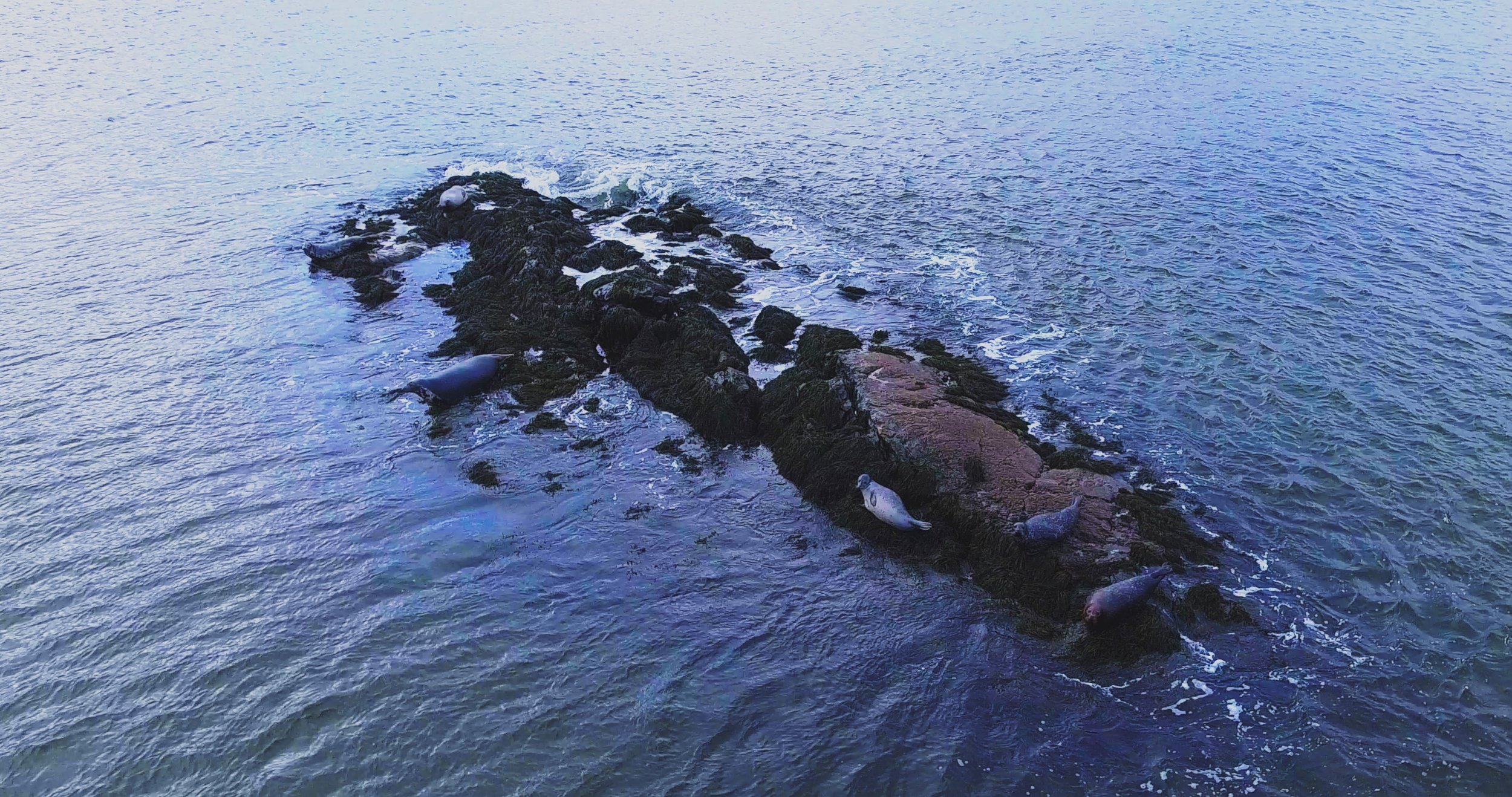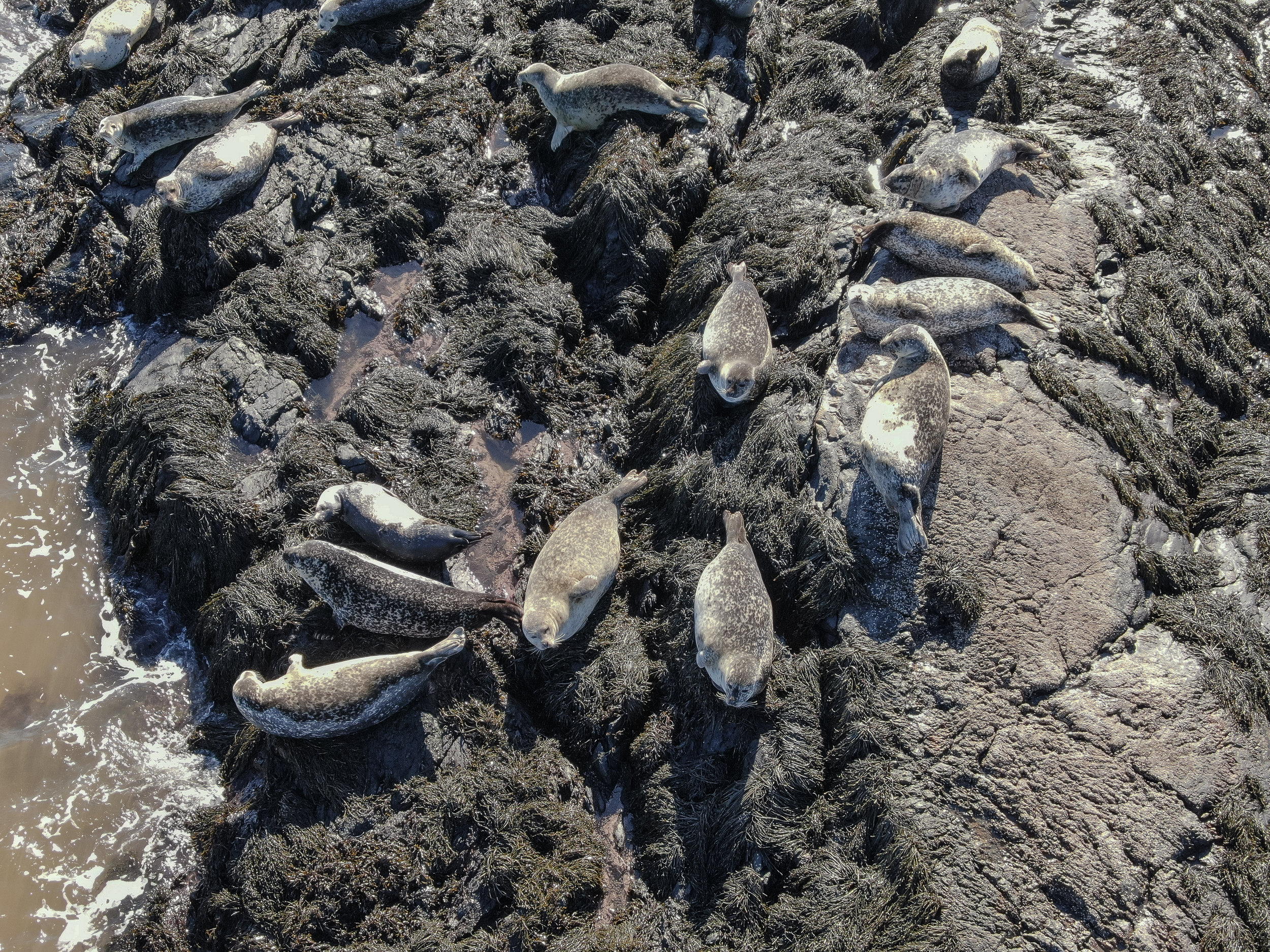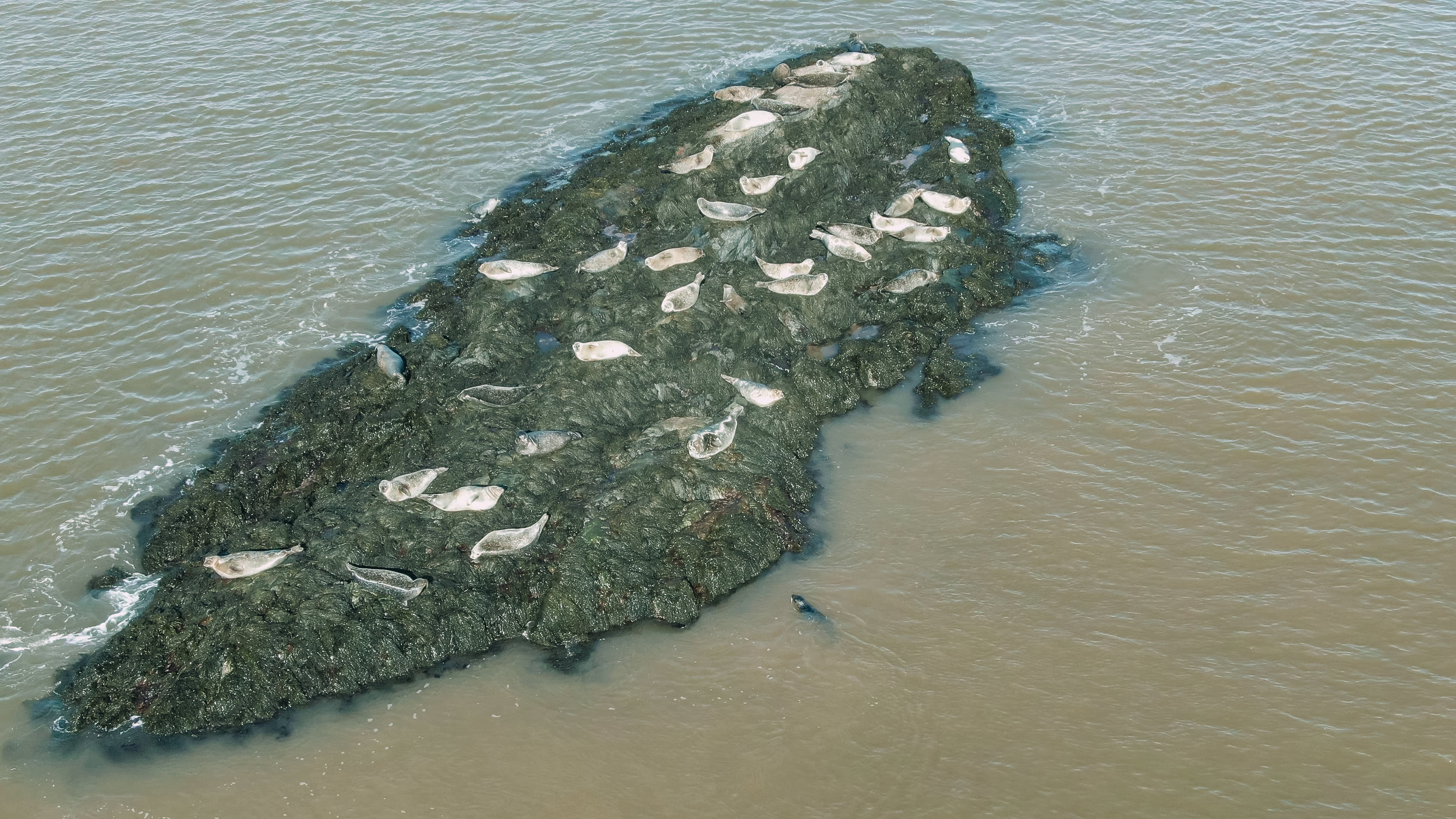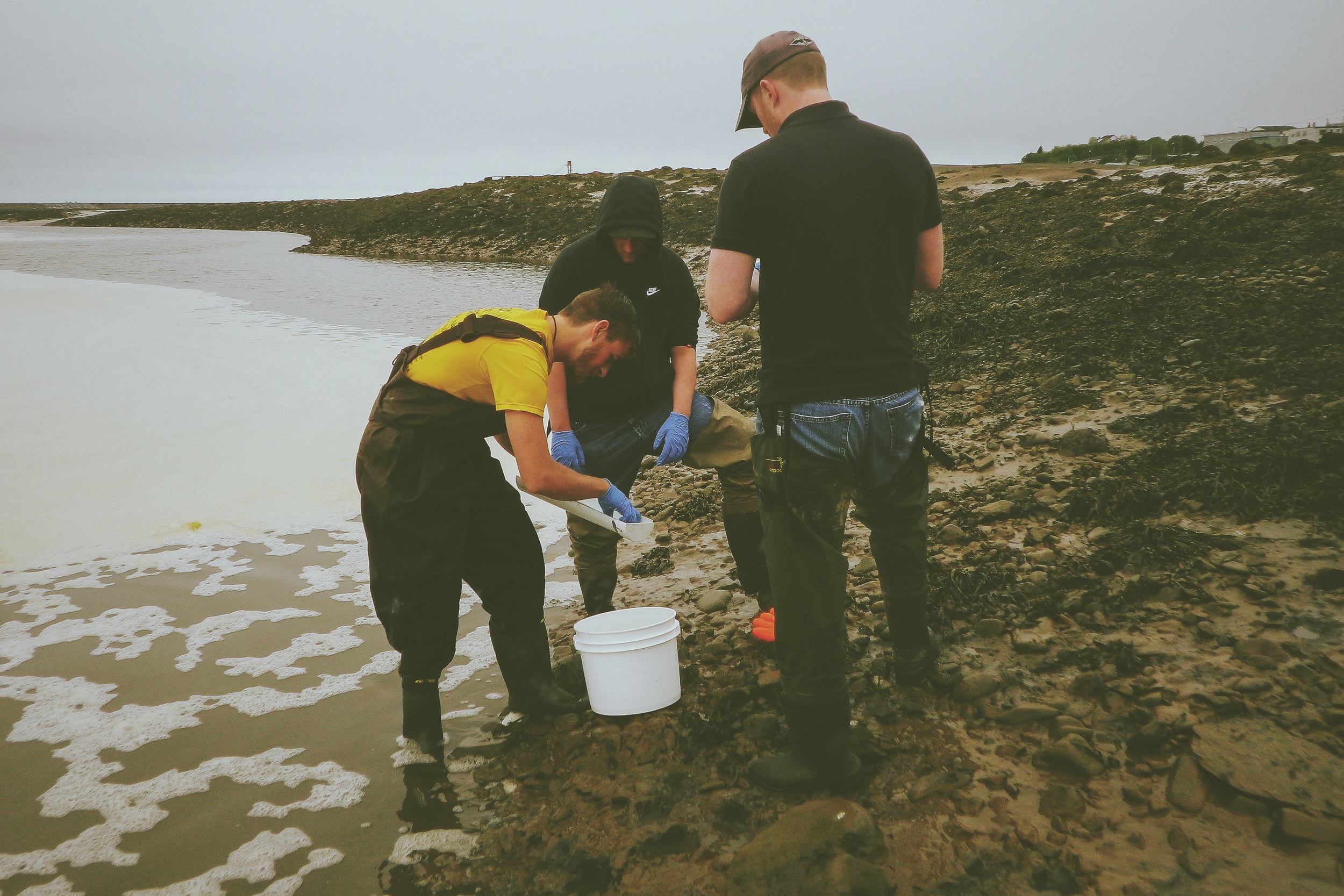
STAFF BLOG
Saint John Sea(l) Dogs
Did You Know?
Did you know that ACAP Saint John has been working on a project observing Harbour seal populations in the Saint John Harbour? This 3-year project (funded by DFO’s Coastal Environmental Baseline Program) involves counting seals as they haul out on rocks at low tide on a biweekly basis. Over time, we are hoping to collect enough data to determine the population numbers of seals in our region and compare it to similar studies that were conducted in the 1990s.
We have six sites that we visit: five sites that are located in the Saint John Harbour and one site located along the Wolastoq [St. John River] (Sea Dog Cove, Summerville). Our observations are conducted every two weeks when the low tide is in the afternoon. Using spotting scopes, binoculars, and (occasionally) drones, we count and record the number of seals that are seen hauled out on the rocks and swimming nearby. Since seals do not migrate south for the winter, we are able to continue with observations throughout the winter (with the exception of the river site since it does freeze).
Map of harbour seal haul out site locations throughout the Saint John Harbour.
Results (so far)
Overall, we’ve been very successful with our sightings. As expected, most sites have more seals in the spring compared to other seasons, likely due to April-June being their mating/pupping season. It was also observed that during the winter months there is a number of seals that haul out at Dog Rocks (along the Irving Nature Park). Since seals don’t necessarily long-distance migrate during the winter, perhaps they move between the different haul out sites throughout the seasons.
Number of seals observed at all haul out sites (excluding Round Reef) from Dec ‘18 - Nov ‘20.
We are very fortunate to have a landowner near the Sea Dog Cove site that completes our freshwater observations for us. She noticed that the seals don’t haul out during the day based on the tides, but based on the time of day. She is more likely to see seals during sunrise and sunset.
Historically there have been sightings of seals on Round Reef (just off Tin Can Beach) and that’s why it was added as an observation site. However, no seals have been observed at this site as of yet! Perhaps they’ve found a better place to sunbathe.
What’s New?
This past summer we teamed up with Gina Lonati, a PhD student from UNBSJ, who is currently studying the health of North Atlantic Right Whale using drones. Gina is helping us by flying her drone over the haul out sites to achieve a more accurate count of the seals. Her fancy drone can also take thermal images of the seals - check it out!
(left): image of seals hauled out at low tide; (right): thermal image of seals hauled out oat low tide. Yellow = hot, blue = cold
What’s Next?
ACAP will continue to collect data for another year. Although it is still too early to make any conclusive results, collecting this data will contribute to filling up data gaps in our region.
CITIZEN SCIENCE
Have you seen any harbour seals lately? We’re interested in hearing from you! If you see any seals at all during your travels, whether they are swimming along the river or hauled out on some rocks, let us know! You can fill out a Seal Sighting Submission Form and let us know how many seals you saw and roughly where you spotted them. This data collected will help us determine the population of seals here in the Saint John Harbour.
Partridge Island Cleanup
Ever since I learned about Partridge Island, the creepy island on Saint John’s West Side, I’ve always wanted to go explore the old structures that are still standing. I’ve heard of many people crossing the dangerous breakwater, jeopardizing their lives climbing over jagged boulders from the mainland to the island, but I was always more concerned about my safety (mostly my clumsiness), and have never taken the risk to see it myself. So, when I was approached by Jim Donahue from River Bay Adventures, a local kayaking company, to help organize a beach/island cleanup along Partridge Island, I jumped on the opportunity!
Organizing this cleanup was easy. I knew that I would have no problem finding volunteers and sponsors. After making a few phone calls, we were fortunate enough to have Cecil McCavour from DMK Marine Services agree to volunteer his time and his boat to help with transporting supplies and garbage. Port Saint John also kindly sponsored our lunch for the event.
On Saturday, September 21 (International Coastal Cleanup Day), 17 eager volunteers arrived bright and early at Bayshore Beach. The sun was shining, and the winds were mild, making it the perfect day for kayaking on the Harbour. Once everyone was geared up, we all hopped into tandem kayaks and paddled over to the island. Since I had never been there before, I had no idea what sort of things I would find. When we arrived, garbage bags and gloves were passed around and the cleanup commenced!
The beach that we landed on was littered with marine debris (i.e. ghost rope, plastic and Styrofoam) likely brought in from the tides. But towards some of the old remaining buildings is where we found the bulk of the garbage and evidence that many people leave their trash laying around when visiting. It was clear that the people that crossed the dangerous breakwater were there to have a good time. Lots and lots of empty beer cans and broken beer bottles were found scattered throughout the buildings, including a great deal of old food wrappers and unidentifiable garbage. Some of the buildings were dark, damp, and in my opinion, very spooky. The floors in these places were covered with garbage, as if the darkness of the bunkers hid the debris enough that no one would notice or care.
I can’t imagine anyone has ever bothered to cleanup this island, probably due to the difficulty of transporting bags of garbage across the breakwater. Hence why I think the garbage has pilled up for so long. Having this experience was eye opening to me that people are still littering and think it is ok to leave their garbage laying around. I hope that people realize that any garbage you leave behind doesn’t disappear after you leave the area. Some items take years, or even decades/ centuries, to decompose!
After 3.5 hours, we were able to cleanup and dispose of approximately 440lbs of garbage and marine debris! Thank you to everyone that participated!
Overall, this was a fantastic event that was enjoyed by all volunteers. I hope to make this an annual event where we can bring out many more volunteers and continue to cleanup the garbage that is left behind. Stay tuned as we plan for the 2nd Annual Partridge Island Cleanup in 2020!
P.S. STOP LITTERING, IT’S NOT COOL.
#BASHTHETRASH
All pictures were taken by ACAP Saint John’s Executive Director, Graeme Stewart-Robertson.
Seal of Approval
It’s not uncommon for Saint Johners to see seals during their travels. Whether they are walking on the Harbour Passage or causally boating along the Wəlastəkw [St. John River]. Even the Saint John Sea Dogs and Port Saint John use the seal as their mascots!
But did you know that there hasn’t been much research conducted on seals in the Bay of Fundy, specifically here in our Harbour? Sure, we know general facts like how much they weigh and what they like to eat, but their population size is currently unknown in our region.
To help fill in some of these data gaps, ACAP has stepped out of their comfort zone to monitor Harbour Seals right here in the Saint John Harbour!
Dr. Terhune from UNBSJ is what I like to call a seal expert. In 1984 and 1987, Dr. Terhune and his team monitored harbour seal numbers along the Southern coast of New Brunswick. Aerial surveys (on a fancy plane might I add) were conducted every two weeks for 12 months (weather permitting). Surveys were completed when low tide occurred in the mid-afternoon at different haul out sites* along the coast and the number of seals that were hauled out were recorded.
*haul out site: a location (such as an intertidal ledge, mudbank, beach or ice flow) where a seal will come completely out of the water and lie quietly for a few hours. In areas like the Bay of Fundy, with high tidal influence, haul out sites are exposed on the falling tide. It’s thought that seals will haul out to rest, for thermoregulation and to avoid predators.
Dr. Terhune found that the seal population took a seasonal shift south (towards Maine and Massachusetts) during the winter (Jacobs and Terhune, 2000). Since their population hasn’t been studied in so long, ACAP Saint John decided to replicate the same methods as Dr. Terhune and have been monitoring different seal haul out sites throughout the Saint John Harbour. Instead of using planes and helicopters to complete our surveys, we have been using spotting scopes, binoculars and drones (directly from shore) to count the seals that haul out.
Our study will take place over the next two years, where we will monitor the different haul out sites biweekly and count and record the number of seals that are seen (including both seals hauled out and any seen swimming around). The black triangles on the map below are where the haul out sites that we have been monitoring are located.
We began monitoring seals in November and seals were observed even throughout the winter months despite the cold. It is still too early to make any conclusive results when it’s only been a few months of observations, but collecting data over the next couple of years will contribute to filling up data gaps in our region.
Map of Harbour Seal haul out site locations throughout the Saint John Harbour.
Citizen Science
Have you seen any harbour seals lately? We’re interested in hearing from you! If you see any seals at all during your travels, whether they are swimming along the river or hauled out on some rocks, let us know! You can fill out a Seal Sighting Submission Form and let us know how many seals you saw and roughly where you spotted them. This data collected will help us determine the population of seals here in the Saint John Harbour.
References
Jacobs, S.R., and J.M. Terhune. 2000. Harbor seal (Phoca vitulina) numbers along the New Brunswick coast of the Bay of Fundy in autumn in relation to aquaculture. Northeastern Naturalist 7:289-296.
Emerald Ash Borer; Coming to an Ash tree near you!
Insects and diseases have been affecting various tree species for centuries: both occur naturally and keep our trees healthy. However, when invasive species are introduced into the lifecycle, the results can become detrimental to our forests.
The Emerald Ash Borer (Agrilus Planipennis), or EAB, is a wood-boring insect originally from Asia and was first detected in Michigan and Southwest Ontario in 2002. It is suspected that this invasive insect was accidently transported to Canada in wood packaging material used on shipping containers. EAB has since spread throughout Ontario, into Quebec, and has recently been detected in Edmundston, New Brunswick (May 17, 2018).
Map showing the current North American distribution of the Emerald Ash Borer from the Cooperative Emerald Ash Borer project. Map last updated on July 2, 2018.
How does EAB kill trees? EAB attacks only true ash trees, including green, white and black ash and targets trees of all sizes. The beetles feed on ash trees in Asia too, but those trees have developed natural defenses due to co-evolved with the insects. EAB begin to destroy ash trees by laying eggs between the crevices of the bark. Once the eggs hatch, the larvae will bore into the tree and chew through the bark, and feed on the phloem and cambium layers, interrupting the flow of nutrients and water that is needed for the trees survival. After overwintering in the tree, the EAB adults (approximately 10 mm in length, no longer than a grain of rice, and metallic green-blue bodies) will emerge in the spring, leaving small, 1/8-inch, diameter D-shape exit holes. This life cycle creates stress on the trees, causing thinning leaves, die-back in the tree’s canopy and bark loss.
Image acquired from: http://remagazine.coop/electric-cooperatives-ash-borer-beetle/ash_beetle_kk_final_03/
Why should I care? Ash trees do not only play an important role along our riparian zones but have been widely planted in our urban forests. Urban forestry plays a major role in reducing storm runoff, urban noise, providing shade and cooling, and filtering pollutants. Ash trees can often be seen planted along city streets due to their tolerance to urban environments. Until now, ash trees had very few diseases or problems with pests. As the spread of the EAB continues east across Canada, ash trees in New Brunswick are at risk of becoming infested with the invasive species, killing thousands of street trees in the province.
Watch out! Since its discovery in Edmundston, it is only a matter of time before EAB is detected in Saint John. During a 2017 street tree inventory of the Central Peninsula, it was found that 14.1% of street tree species were true ash species. Once the emerald ash borer finds it way to Saint John, ash trees, both in the rural and urban environments, will be lost due this invasive species.
Green and white ash trees found along the streets of the central peninsula surveyed during a street tree inventory (2017).
What can I do? It’s crucial that we educate the public about the long-term effects of EAB and how we can work together to be ready for the invasion of these pests.
- The Emerald Ash Borer is most commonly spread through the movement of firewood and other infested ash wood products. If you transport infested wood you could be helping spread this invasive species across the country. Help prevent the spread of these pests by buying firewood where you will be burning it.
- If you happen to have an ash tree on your property, consider planting new trees to replace lost canopy. Great native, deciduous trees to choose from include Bur oak, Red oak, American linden and Sugar maple. Planting a tree on your property is an important step in making our urban forest healthier in the future.
- Learn how to identify EAB, as well as their signs and symptoms they leave behind. Check out Natural Resources Canada to find out more information.
Buy local. Don’t move your firewood.
References:
- Natural Resource Canada (2016). "Emerald ash borer (factsheet)". Retrieved from: https://www.nrcan.gc.ca/forests/fire-insects-disturbances/top-insects/13395
From Pet to Pest
The Invasive Goldfish
Did you know that invasive species are the second biggest threat to biodiversity after habitat loss? Do you ever wonder how some of our invasive species initially arrived to New Brunswick? Alien species can arrive in several ways, including ships, vehicles, machinery, humans and the dispersal via wildlife, wind and water from nearby infested areas. Some species were accidently introduced through ballast water on ships (i.e. zebra mussels, European green crab), while others were intentionally introduced due to benefit humans without knowing that the species would become invasive (i.e. rock pigeons, Japanese knotweed).
Invasive species can thrive in their new environments because they have very few or no natural predators or other elements that would normally keep them in check. These new introduced species have the ability to outcompete our native species for resources (habitat, food and shelter). In just a short time, invasive species can spread across the country if they are not controlled.
Last week, we got a phone call from a local school concerned about the amount of goldfish that can be found in their campus storm water pond. It's thought that students have been dumping their unwanted pets into this waterbody for years when they leave for summer vacation/graduation. You might be asking yourself: what is so harmful about a few goldfish in a natural environment? The answer is: everything. Goldfish are becoming one of the worst invasive aquatic species in the world. These fish are able to tolerate changes in water temperature, as well as water with low levels of dissolved oxygen, and will primarily feed on fish eggs, larvae and aquatic plants – outcompeting our native aquatic species. Goldfish can grow quickly and up to 40 cm in length!
We teamed up with the students from the school to collect as many goldfish as we could out of the pond, and to educate them on the dangers of invasive species. The students suited up in waders, grabbed nets, and began corralling fish.
Students waist deep in the stormwater pond on school property trying to capture introduced goldfish.
Despite the rain, the students had a great time catching fish. It was even some of the students first time in chest waders – which is a whole different experience in itself. With the help of spectators, students were able to catch almost 25 goldfish! After speaking to some of the teachers from the school, I was informed that there were approximately 80+ goldfish living in this pond. Although the students were not able to catch all the fish, it was thought that this could a be a fun, recurring activity in the future for the students until all the fish are gone.
Some of the goldfish that were caught using using handheld nets.
One of the main questions I received during this workshop was: “what will you be doing with these fish when we go back to class?”. When I was first asked to lead this workshop, I didn’t really have a plan, as I didn’t have a tank at the office or at home to put the fish in. I decided to call one of our local pet supply stores to see if they would be interested in adopting the goldfish that had been collected. Without hesitation, they told me to bring them over and they would find them a new home.
I’m hoping that the students learned something from this experience – whether it was about not dumping their unwanted fish into lakes and streams or about general invasive species education. Remember, this situation also relates to everyone! If for any reason you cannot take care of your aquarium fish, please DO NOT dump them into a nearby stream, look for other alternatives:
- Ask a family member/friend if they are interested in adopting your fish – many people have fish tanks in their home and may gladly take these critters off your hands.
- Call your local aquarium – as long as the goldfish haven't grown to 40 cm in length, these facilities will usually take your unwanted pet (as it can be seen as free merchandise for them).
Goldfish being introduced to their new aquarium home.


